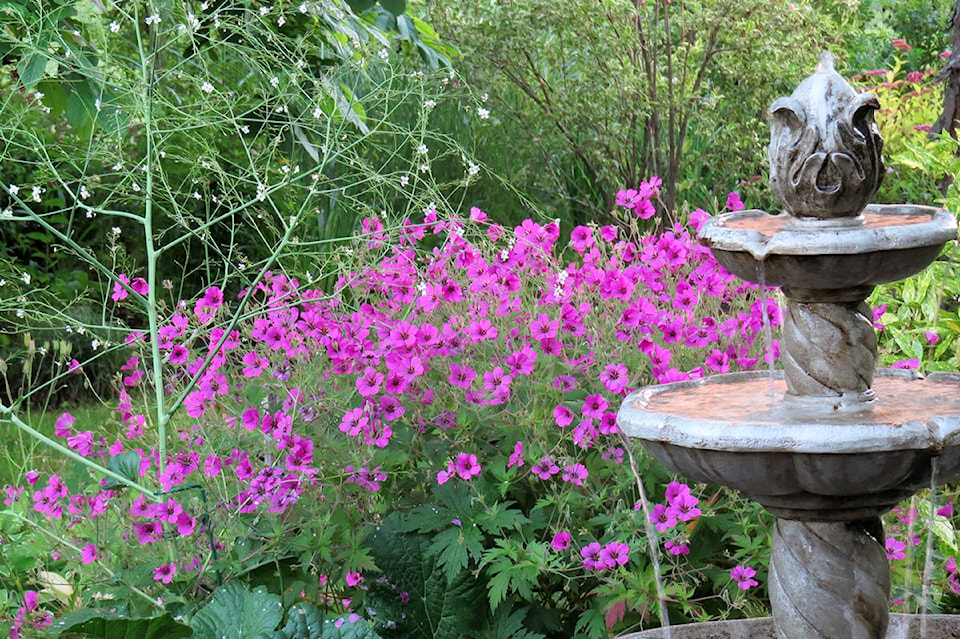Leslie Cox
Special to The Record
Just when you thought you had all the garden chores wrapped up and could relax in the heat of summer… think again. The plants still need your attention and I am not merely talking about the watering chore.
Have any shrubs which have finished flowering? Rhododendrons and azaleas should have their spent flowers removed to tidy up the plant. They also need the rest of the growing season to produce next year’s flower buds.
You should also prune your Choisya (Mexican mock orange), forsythia, viburnum, deutzia, weigela, flowering quince, flowering currant, daphne, and any other shrub you have which has finished its flowering cycle by now. (Use hedging shears turned upside down to quickly shape your more rounded shrubs, like Choisya.)
Treat the plants that have “done their thing” and had a pruning to a side-dressing of compost or fertilizer. They will thank you for the nutrient replacement.
Peonies and hellebores should be deadheaded and all ratty or diseased foliage removed. Put this debris directly into the garbage! These two species are susceptible to botrytis which you do not want in your compost.
Turning to the annuals… regularly deadhead the spent flowers. These plants will keep producing new flowers in an attempt to set seed.
As for the perennials, there are a few early flowering species which will reward you with a second flush of flowers if the spent blossoms are removed now. These include: many of the herbs, some salvias, centranthus (red valerian) and Phuopsis stylosa (creeping crosswort).
A few of the perennials with those tall spikes of flowers, such as delphinium, verbascum (mullein), foxglove and the six-foot tall Campanula lactiflora ‘Loddon Anna’ can often surprise you. If you cut off the flower stalk just at the top set of leaves, you may see small stems of flowers developing from the crotches of leaves lower down on the stem.
For sure deadhead those wicked self-seeders as soon as the flowers are finished, if not before! I am talking about plants such as feverfew (Tanacetum parthenium), columbine, lychnis, foxglove, verbascum and some of the grass species like Milium effusum ‘Aureum’ (golden wood millet).
Primulas - especially the P. vulgaris species - are good self-seeders too. But save yourself some time and cut the whole plant back, leaves and all. The foliage is likely looking a little ratty now anyways. Before too long, if you keep the roots watered, you will see a fresh flush of leaves popping up out of the ground, but not likely you will get another round of flowers.
Hardy geraniums benefit from the same treatment when they have finished flowering. The tall Geranium phaeum ‘Samobor’ is definitely one variety that responds well to a complete buzz cut. New leaves soon appear and often, another round of flowers later in the season. By the way, this is one hardy geranium which grows well in almost complete shade.
On the other hand, Geranium psilostemon or Armenian cranesbill, will continue to flower throughout most of the summer if you cut off the spent flowers so it cannot set seed. Keep it watered too. Foliage can look pretty tired after weeks of relentless sun.
Turning to the vegetable garden… thin those beets and carrots if you have not done so already. And in this heat, early planted lettuces are starting to bolt. Start some seed indoors to transplant out for a continued supply of salad greens. (Don’t direct sow lettuce seed in the ground as soil temperature is too hot for good seed germination.)
Garden chores need attention but please be kind to yourself. Do them in the cool of the morning and enjoy a place in the shade when the sun is high.
ALSO: Lessons learned in Junuary
Leslie Cox co-owns Growing Concern Cottage Garden in Black Creek. Her website is at www.duchessofdirt.ca
